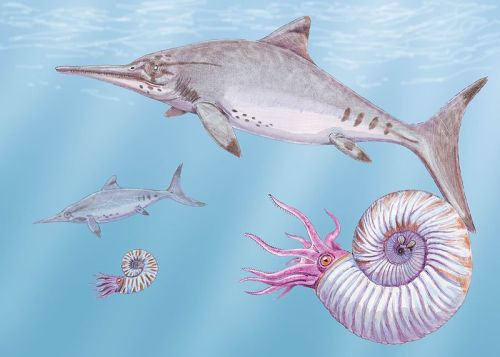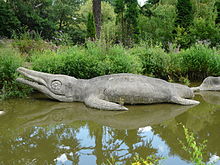
Artwork by Dmitry Bogdanov (wikimedia)
| Ichthyosauria | ||
| The Vertebrates | Overview |
| Vertebrates Home | Vertebrate | Vertebrate |
|
Abbreviated Dendrogram
Diapsida
╞═Younginiformes
└─┬─┬?─Thalattosauria
│ └─○Ichthyopterygia/Ichthyosauria
│ ├─Utatsusaurus
│ └─┬─Ichthyosauria
│ └─┬─Merriamosauria
│ └─┬─Euichthyosauria
│ └─┬─Parvipelvia
│ ├─Eurhinosauria
│ └─┬─Thunnosauria
│ └─Ophthalmosauria
└─┬─Lepidosauromorpha
└─Archosauromorpha
|
Contents
Overview |
 |
| The advanced Ichthyosaur Ophthalmosaurus yasikovi (with ammonites), from the Late Jurassic of Central Laurasia Artwork by Dmitry Bogdanov (wikimedia) |
 |
| Benjamin Waterhouse Hawkins' lifesize model of Ichthyosaurus, one of a number of sculptures of prehistoric animals that accompanied the renovated Crystal Palace, and were made in collaboration with Richard Owen and other leading scientific figures of the time. Unveiled in 1854, these were the first ever life-sized models of extinct animals. Compare with the more realistic reconstruction above. Ironically, Hawkins' sculpture provides a not unreasonable representation of the more basal, eel- or serpent-like, early to middle Triassic Ichthyosaurs (although obviously the bony ring supporting the eyeball would not be visible in the living animal). (wikimedia). |
The Ichthyosaurs ("fish lizards") were a very successful group of air-breathing Mesozoic marine reptiles that bore an uncanny resemblance to modern day (late Cenozoic) dolphins. Along with the plesiosaurs, the ichthyosaurs were among the first Mesozoic reptiles to be discovered, and the two groups of "antediluvian monsters" had a strong effect on the 19th century Victorian imagination (right). (Glendening, 2009)
Ichthyosaurs were very diverse early in their history (during the Triassic period), where they began as smallish (~1 m) elongate eel-like swimmers but soon evolved into the largest marine reptiles that ever lived (up to 15 to 20 meters and more - the size of whales). These Triassic ichthyosaurs were very different ecologically from their Jurassic descendants, mostly longer bodied with long, broad tails. They probably tended to be ambush predators with more generalized prey preference, as shown by the heterodonty (different tooth sizes and shapes) in many Early and Middle Triassic species. ( Massare & Callaway 1990)
During the late Triassic they developed their familiar deep, streamlined bodies and lunate tails, and this morphotype continued through the Jurassic and Cretaceous. These ichthyosaurs were mainly pursuit predators, altthough transitional forms like the giant toothless Shonisaurus were relatively slow moving and probably fed on cephalopods (Nicholls & Makoto 2004 ). The late Triassic and early Jurassic were the high points of the Ichthyosaur reign. The Toarcian turnover seems to have affected them heavily and only a single clade made it through to the middle Jurassic, the very succesful Ophthalmosaurs. Although the Ichthyosaurs straggled on to the mid Cretaceous (Cenomanian age) they never regained their previous dominance, there place as top marine predator being taken by large pliosaurs. and later mosasaurs
Despite their dolphin-like form, ichthyosaurs lacked the stamina of modern marine mammals. They were sprinters, not endurance swimmers, with a typically reptilian metabolism. The reason for their decline may have been tied up with an inability to keep up with the new fast swimming Teleost fish that appeared during the Jurassic, or perhaps also faster belemnite cephalopods. The Cretaceous Platypterygius however seems to have been a more opportunist feeder (Kear et al 2003).
Being so fish-like in form, ichthyosaurs could not crawl up onto the land to lay their eggs. Instead, the eggs remained in the mother until they hatched. She then gave birth to live young. Skeletons of baby ichthyosaurs have been found inside the skeletons of adults. MAK991007, 100925.